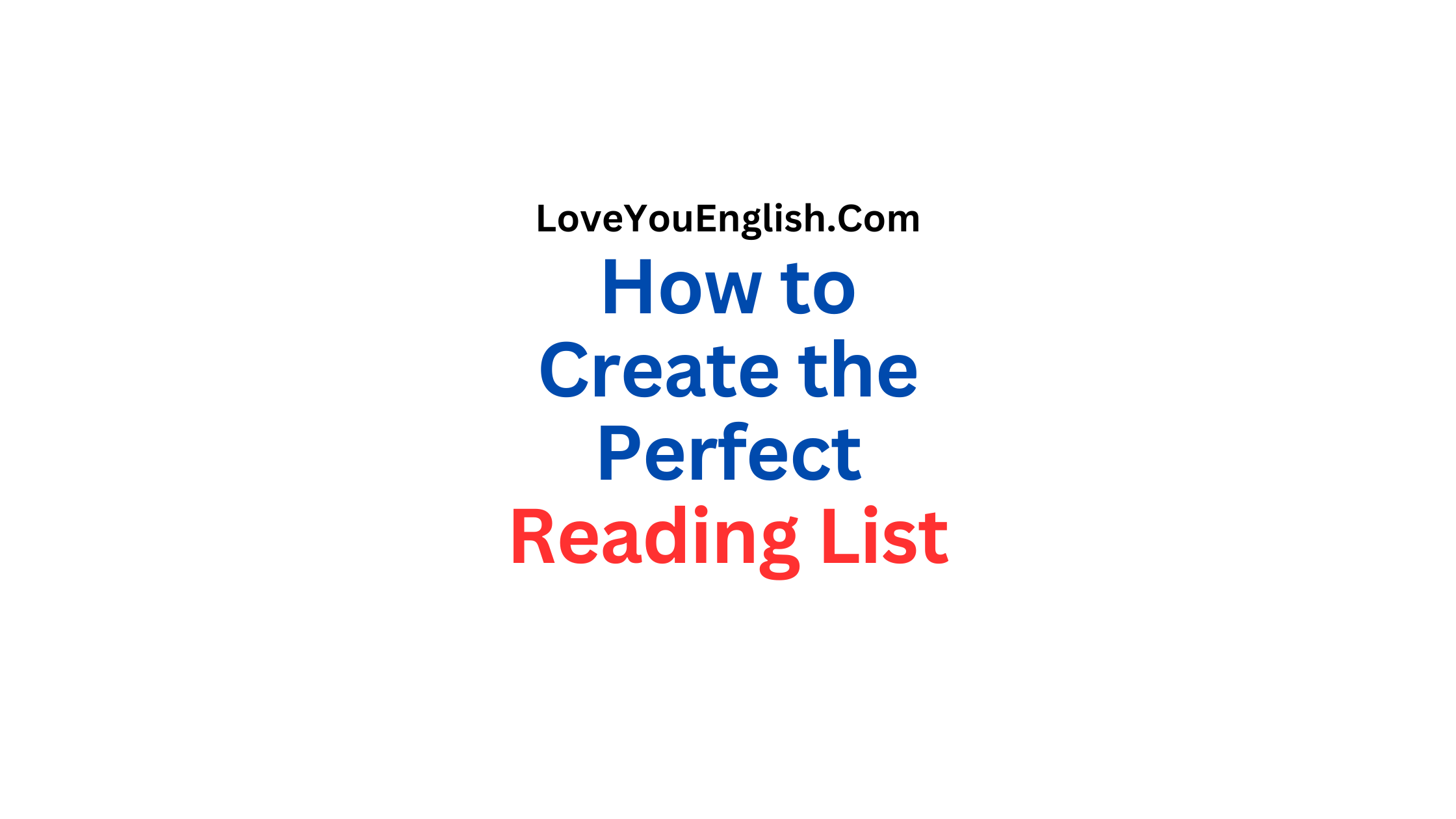How to Create the Perfect Reading List
The Ultimate Guide to Creating Your Perfect Book Reading List
Have you ever felt overwhelmed by the sheer number of books out there?
Or maybe you’ve found yourself in a reading rut, unsure of what to pick up next?
Don’t worry – you’re not alone! Creating a book reading list can be a game-changer for your reading life.
In this post, we’ll explore everything you need to know about crafting the perfect reading list that’ll keep you excited and engaged with books all year round.
Why Create a Book Reading List?
Before we dive into the how-to, let’s talk about why having a reading list is so awesome:
It keeps you organized:
No more forgetting about that book your friend recommended months ago!
It helps you set goals:
Whether you want to read more or branch out into new genres, a list can help you stay on track.
It saves time:
Instead of endlessly browsing bookstore shelves or online stores, you’ll always know what’s next on your list.
It broadens your horizons:
A well-planned list can introduce you to new authors, genres, and ideas you might have missed otherwise.
It’s motivating:
Checking books off your list gives you a sense of accomplishment and encourages you to keep reading.
Now that we know why reading lists rock, let’s get into the nitty-gritty of creating one that works for you!
Step 1: Reflect on Your Reading Habits and Goals
Before you start jotting down titles, take a moment to think about your reading life:
- How many books do you typically read in a year?
- What genres do you enjoy most?
- Are there any types of books you’d like to try but haven’t yet?
- Do you prefer physical books, e-books, or audiobooks?
- What are your reading goals for the upcoming year?
Being honest with yourself about your habits and aspirations will help you create a list that’s both exciting and achievable.
Step 2: Gather Book Ideas
Now comes the fun part – brainstorming books to add to your list! Here are some great places to find inspiration:
Best-seller lists:
Check out The New York Times Best Sellers or Amazon’s charts for popular picks.
Award winners:
Look up recent winners of the Pulitzer Prize, Booker Prize, or genre-specific awards like the Hugo Awards for science fiction.
Recommendations from friends and family:
Ask your bookworm buddies what they’ve loved lately.
This social network for readers is a goldmine of recommendations based on books you’ve enjoyed.
Bookstagram and BookTok:
Instagram and TikTok have thriving book communities full of passionate readers sharing their favorites.
Your local library or bookstore:
Browse the shelves or ask librarians and booksellers for suggestions.
Many websites and book clubs offer annual reading challenges with specific categories to guide your choices.
Your own shelves:
Don’t forget about those books you’ve been meaning to read but haven’t gotten around to yet!
More cool topics:
- 9 Elevator Pitch Examples to Ensure You Stand Out
- How to Make Small Talk That Doesn’t Feel Like Small Talk
- Centers for Career Development: A Guide to Professional Success
- Exit Interviews: A Complete Guide
Step 3: Choose Your List Format
There’s no one-size-fits-all approach to organizing your reading list.
Pick a method that works for you:
- A simple notebook or journal
- A spreadsheet (great for tracking multiple details about each book)
- A digital note-taking app like Evernote or OneNote
- A dedicated reading app like Goodreads or StoryGraph
- A bullet journal for a more creative approach
Whatever format you choose, make sure it’s something you’ll actually use and enjoy updating.
Step 4: Decide on List Categories
To keep your list organized and balanced, consider breaking it down into categories.
Here are some ideas:
Genre (fiction, non-fiction, mystery, sci-fi, etc.)
Purpose (entertainment, education, personal growth)
Length (short stories, novellas, epics)
Diversity (books by authors from different backgrounds or countries)
Time periods (classics, contemporary, future releases)
Personal goals (books for work, hobby-related reads)
You can mix and match these categories or come up with your own.
The key is to create a system that makes sense to you and helps you achieve a well-rounded reading experience.
Step 5: Set Realistic Goals
It’s easy to get carried away when making a reading list but remember – quality is more important than quantity.
Here are some tips for setting achievable goals:
Start small:
If you’re new to reading lists, aim for 12 books (one per month) and adjust as needed.
Be flexible:
Leave room in your list for spontaneous reads or new releases that catch your eye.
Mix it up:
Alternate between longer, more challenging books and quicker, lighter reads to maintain momentum.
Consider your schedule:
If you know you’ll be busy during certain months, plan for shorter or audiobooks during those times.
Reassess regularly:
It’s okay to modify your list as the year goes on. Your interests and circumstances might change!
Step 6: Add Variety to Your List
A diverse reading list can help you grow as a reader and a person.
Here are some ways to mix things up:
Try new genres:
If you usually stick to fiction, throw in a non-fiction book or two. Love romance? Give a thriller a shot!
Read diverse authors:
Include books by writers from different cultures, ethnicities, and backgrounds than your own.
Mix formats:
If you usually read print books, try an e-book or audiobook for a change of pace.
Blend old and new:
Include both classics and contemporary works on your list.
Go global:
Pick books set in different countries or written by international authors.
Vary length:
Include a mix of short stories, novellas, and longer novels.
Include re-reads:
Sometimes revisiting a favorite book can be just as rewarding as discovering a new one.
Step 7: Prioritize Your List
Once you’ve got a solid list of books, it’s time to decide what order you’ll tackle them in.
Here are some approaches:
Chronological: Read books in the order you added them to your list.
Seasonal: Match books to the time of year (beach reads in summer, cozy mysteries in winter).
Alternating: Switch between genres or formats to keep things fresh.
Mood-based: Group books by emotion or theme and choose based on what you’re feeling.
Random: Use a random number generator to pick your next read for a fun surprise!
Remember, your reading order doesn’t have to be set in stone. Feel free to jump around if you’re in the mood for something different.
Step 8: Make Your List Visible
Out of sight, out of mind – don’t let this happen to your reading list!
Keep it somewhere you’ll see it often:
Pin it to your bulletin board
Set it as your phone or computer wallpaper
Use a reading journal that sits on your nightstand
Create a vision board with book covers
The more you engage with your list, the more likely you are to stick with it.
Step 9: Join a Reading Community
Reading can be a solitary activity, but sharing your journey with others can make it even more enjoyable.
Consider:
Joining a local book club
Participating in online reading groups
Following bookish accounts on social media
Starting a reading challenge with friends
Attending author events or book festivals
Connecting with fellow readers can provide motivation, new perspectives, and great book recommendations to add to your list.
Step 10: Track Your Progress
As you work through your reading list, keep track of your progress.
This can be as simple or detailed as you like:
- Date started/finished
- Rating out of 5 stars
- Brief thoughts or review
- Favorite quotes
- Whether you’d recommend it to others
Tracking your reads can help you reflect on what you enjoy and inform your choices for future lists.
Step 11: Be Open to Adaptation
Your reading list should be a guide, not a cage.
Don’t be afraid to:
- Abandon books that aren’t working for you
- Add new discoveries to your list
- Shuffle the order based on your mood or circumstances
- Adjust your goals if life gets busy
Remember, the point is to enhance your reading life, not stress you out!
Step 12: Celebrate Your Achievements
As you complete books on your list, take time to celebrate your progress:
- Treat yourself to a new book or bookish accessory
- Share your accomplishments on social media
- Have a movie night for a book-to-film adaptation you’ve read
- Write a blog post or create a video about your reading journey
Recognizing your efforts will keep you motivated to continue exploring new books.
Bonus Tips for Reading List Success
Create a “To Be Read” (TBR) jar:
Write book titles on slips of paper and draw one when you’re not sure what to read next.
Use the “rule of 50”:
If you’re not enjoying a book by page 50, give yourself permission to move on.
Pair books with activities:
Choose reads that complement your hobbies or travel plans.
Try reading multiple books at once:
Have different books for different moods or times of day.
Set aside dedicated reading time:
Even 15 minutes a day can help you make progress on your list.
Use bookmarks or sticky notes:
Mark passages you want to remember or discuss with others.
Keep a reading journal:
Jot down thoughts, questions, and reflections as you read.
Explore prequels, sequels, or companion books:
If you love a book, see if there are related works to add to your list.
Don’t compare your progress to others:
Everyone’s reading journey is unique.
Revisit and revise your list regularly: Your tastes and goals may change over time, and that’s okay!
Common Reading List Challenges (and How to Overcome Them)
“I don’t have time to read.”
Solution: Start small with 10 minutes a day, or try audiobooks during your commute or while doing chores.
“I keep getting distracted by my phone.”
Solution: Use apps that block social media during reading time, or switch to physical books for a screen break.
“I feel guilty if I don’t finish a book.”
Solution: Remember that life’s too short for books you don’t enjoy. It’s okay to DNF (Do Not Finish)!
“I can’t decide what to read next.”
Solution: Ask a friend to pick for you, or use a book recommendation website based on your past likes.
“I’m intimidated by long books.”
Solution: Break them into manageable chunks, or alternate long books with shorter ones.
“I forget what I’ve read.”
Solution: Write brief summaries after finishing each book, or discuss them with a reading buddy.
“My to-read list is overwhelming.”
Solution: Focus on a smaller, curated list for each month or season instead of your entire backlog.
Wrapping Up
Creating and maintaining a book reading list can transform your reading life from a haphazard hobby into an exciting, purposeful journey.
Remember, the perfect reading list is one that works for you – it should inspire and motivate you, not feel like a chore.
Start small, be flexible, and most importantly, have fun with it!
Your reading list is a personal adventure, a roadmap to new worlds, ideas, and experiences.
Whether you’re aiming to read more, diversify your literary diet, or simply keep track of your bookish adventures, a well-crafted reading list can be your trusty companion.
So, grab a notebook, fire up your favorite app, or pull out that neglected spreadsheet.
It’s time to embark on your next reading adventure, one book at a time.
Happy reading!







